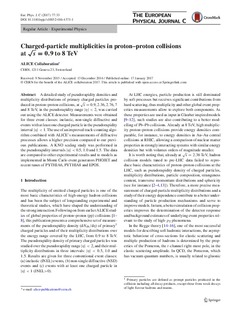Charged-particle multiplicities in proton-proton collisions at √s = 0.9 to 8 TeV
Adam, Jaroslav; Adamová, Dagmar; Aggarwal, Madan M.; Aglieri Rinella, Gianluca; Agnello, Michelangelo; Agrawal, Nikita; Ahammed, Zubayer; Ahmad, Shafiq F.; Ahn, Sang Un; Aimo, Ilaria; Alme, Johan; Helstrup, Håvard; Hetland, Kristin Fanebust; Kileng, Bjarte; Altinpinar, Sedat; Djuvsland, Øystein; Haaland, Øystein Senneset; Huang, Meidana; Lønne, Per-Ivar; Nystrand, Joakim; Rehman, Attiq ur; Røhrich, Dieter; Tambave, Ganesh Jagannath; Ullaland, Kjetil; Velure, Arild; Wagner, Boris; Zhang, Hui; Zhou, Zhuo; Zhu, Hongsheng; Arsene, Ionut Christian; Bätzing, Paul Christoph; Dordic, Olja; Lindal, Svein; Mahmood, Sohail Musa; Milosevic, Jovan; Qvigstad, Henrik; Richter, Matthias; Røed, Ketil; Skaali, Toralf Bernhard; Tveter, Trine Spedstad; Wikne, Jon Christopher; Zhao, Chengxin; Langøy, Rune; Lien, Jørgen; Aiola, Salvatore; Akindinov, Alexander; Alam, Sk Noor; Aleksandrov, Dimitry; Alessandro, Bruno; Alexandre, Didier; ALICE, Collaboration
Journal article, Peer reviewed
Published version
Permanent lenke
http://hdl.handle.net/11250/2502001Utgivelsesdato
2017Metadata
Vis full innførselSamlinger
- Institutt for mikrosystemer [546]
- Publikasjoner fra CRIStin [3623]
Sammendrag
A detailed study of pseudorapidity densities and multiplicity distributions of primary charged particles produced in proton–proton collisions, at √s = 0.9, 2.36, 2.76, 7 and 8 TeV, in the pseudorapidity range |η| < 2, was carried out using the ALICE detector. Measurements were obtained for three event classes: inelastic, non-single diffractive and eventswith at least one charged particle in the pseudorapidity interval |η| < 1. The use of an improved track-counting algorithm combined with ALICE’s measurements of diffractive processes allows a higher precision compared to our previous publications. A KNO scaling study was performed in the pseudorapidity intervals |η| < 0.5, 1.0 and 1.5. The data are compared to other experimental results and to models as implemented in Monte Carlo event generators PHOJET and recent tunes of PYTHIA6, PYTHIA8 and EPOS.

